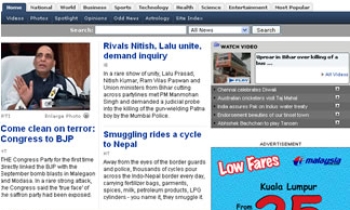Market compulsions make strange bedfellows. So it has, of Microsoft and Yahoo who have decided to marry their instant messaging (IM) services in a bid to take on market leader America Online (AOL). The move comes just as the popular communications tool is beginning to expand into video chatting and Internet telephone functions.

The two companies announced on Wednesday that the partnership will focus on traditional instant messaging, allowing people with either system to send lightning-fast messages to each other. The process will be complete by June 2006, but the companies did not disclose financial terms. The deal, however, does not apply to higher-level services, such as tying IM to search, online music or photo sharing; nor do the companies plan to enter an advertising agreement.
The partnership will give the companies more power to compete against market leader AOL, a division of Time Warner Inc, and new entrants Google Inc, which launched its Google Talk in September. The Yahoo-Microsoft partnership gives the companies nearly as many US users (49.2 million) combined as AOL has (51.5 million) in total.
At stake is the ability to attract users and offer them other services and information from the Web portals, which in turn helps Microsoft's MSN Internet unit, Yahoo, and AOL earn their advertising dollars. AOL's instant messaging client, AIM, had 51.5 million unique US users in September, compared to 27.3 million for MSN Messenger and 21.9 million for Yahoo Messenger, according to Nielsen/NetRatings. Worldwide, this IM marriage is expected to unite 275 million people. AOL will be pushed to the second spot with 100 million users.
IM services such as Yahoo Messenger and MSN Messenger are popular with business users, teens and others because they let people communicate quickly and easily over the Internet, much like a regular conversation. The services are expected to grow more popular as they add more sophisticated tools, such as the ability to place calls or have video chats. Until now, users of one company's IM product have been unable to talk to those signed up to another service.
With that having been bridged between Yahoo Messenger and MSN Messenger, the two companies now hope to be able to let users make computer-to-computer phone calls as well, but they couldn't say when that would happen. This may also provide a way to battle companies like Skype Technologies SA, the Internet phone provider being acquired by eBay Inc. Skype's voice over Internet protocol software has been downloaded 163 million times worldwide. Ebay competes with Yahoo and Microsoft in online retail.

This will also come as a blow to telephone companies that provide a bridge between the IM windows and traditional telephones or cell phones. For now, they are left out of the financial opportunity of the largest-ever community of potential Internet telephone users. For instance, IM users can, and some do, pay a few pennies a minute to make calls from their IM window to cell phone or traditional home phones.
Yahoo Chief Executive Terry Semel called it "a turning point for the IM industry," which has taken years to work out ways for users of rival services to connect to each other. "IM interoperability is the right thing for our customers, our businesses and the industry as a whole, and Microsoft is delighted to help lead these efforts with Yahoo," Semel's Microsoft counterpart, Steve Ballmer, said in a release.
The partnership may have its flipside too. Though both Yahoo and Microsoft have pledged to keep this interoperability safe and secure, experts have warned that it could act as a conduit for a massive IM worm outbreak. IM service users are being hit with more worm and malicious code attacks than ever before.
The number of threats detected for IM and peer-to-peer networks rose 3,295 percent in the third quarter of 2005, compared with last year, according to a recent IMlogic report. The alliance could turn up the heat on people using Yahoo IM. Microsoft's network is the most popular object of IM worms, as 62 per cent of attacks in the third quarter this year were aimed at MSN Messenger or Windows Messenger, IMlogic said. In the same period, only 7 percent of IM worms went after Yahoo Messenger. AOL is supposed to be relatively safe.









